Navies have long believed that seamanship and shiphandling are best learned at sea, particularly on sailing ships. Initially, virtually all naval training was conducted at sea, but as ships grew more complicated, some work began to move to shore facilities and hulked ships. And even as sail gave way to steam in the 19th century, many clung to this belief, with rather odd results, such as the existence of a small fleet of sailing ships with unpaid crews, as many nations required sail experience to get a merchant mariner's license. The argument advanced by proponents of sail was that it taught seamanship, particularly an understanding of wind and current, in a way that simply couldn't be matched by powered vessels, as well as giving cadets a chance to learn leadership and teamwork.
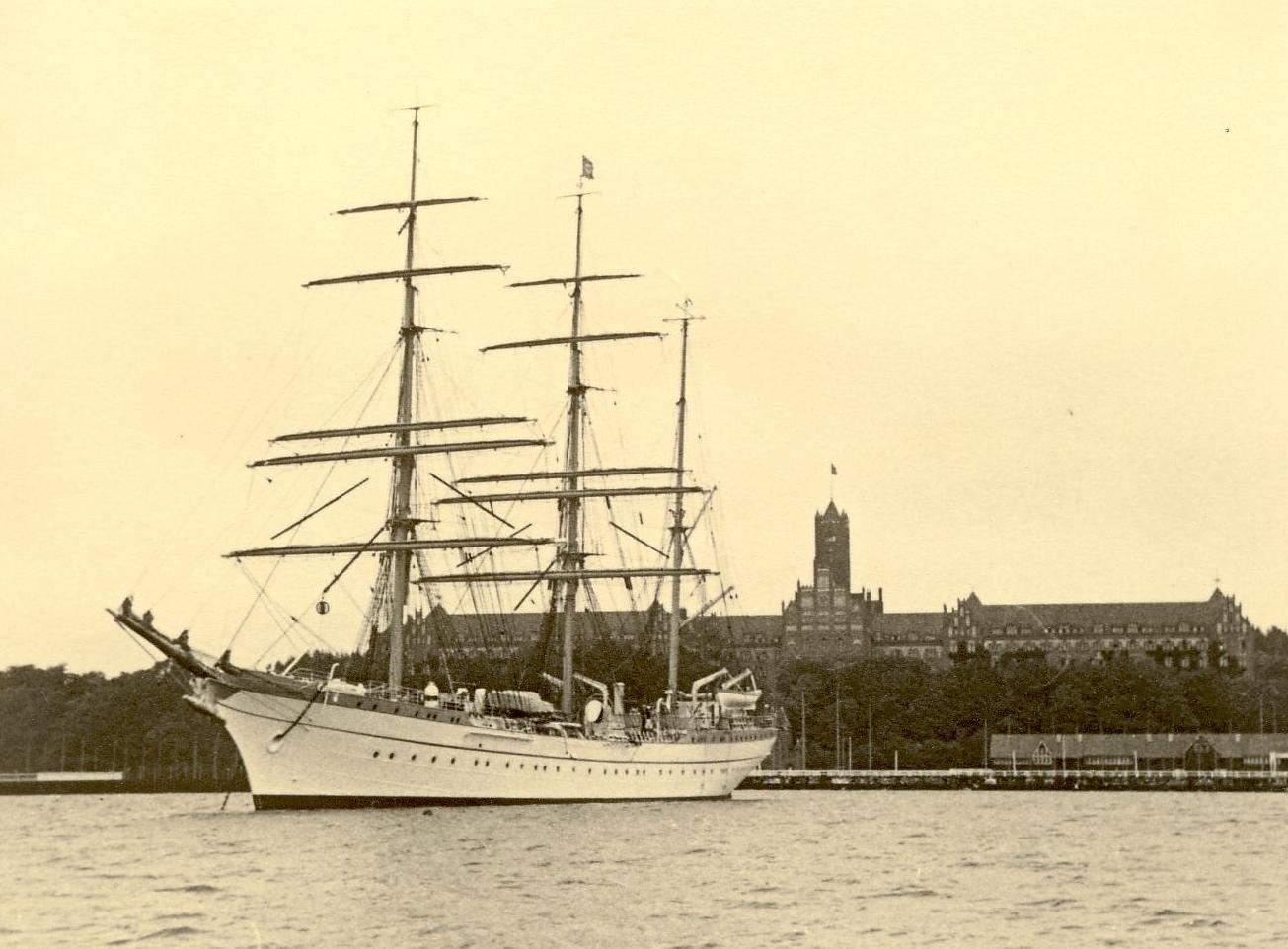
Horst Wessel in Nazi service
How seriously this was taken varied greatly between navies. Some, such as the USN and RN, were quick to abandon sail training on seagoing ships, although small-boat sailing remains part of the curriculum at the US Naval Academy at Annapolis to this day. Others took it far more seriously, building new steel-hulled training ships for the benefit of future officers. Among the leading proponents of this view was Germany. The German training ship Niobe was sunk in a squall in 1932 with heavy loss of life, and public support was rallied for the building of a replacement, named Gorch Fock. She was a steel-hulled barque,1 and proved successful enough that the Kriegsmarine ordered two stretched sister ships, Horst Wessel and Albert Leo Schlageter, named after heroes of the Nazi party. A fourth ship was built for Romania, while a fifth, Herbert Norkus, was cancelled incomplete when war broke out. Gorch Fock spent the war primarily as an accommodations ship, while Horst Wessel and Albert Leo Schlageter, now equipped with light AA guns, continued to conduct training cruises in the Baltic.
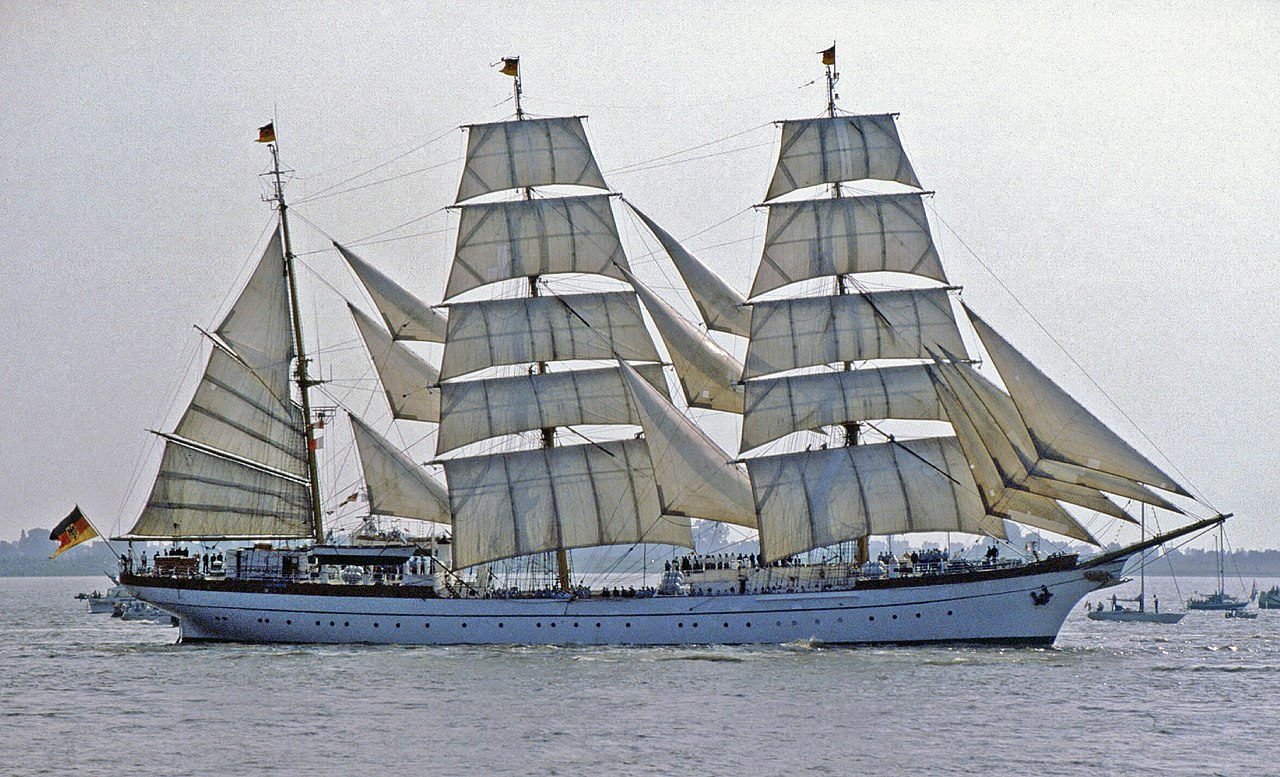
The replacement Gorch Fock under sail
Gorch Fock was scuttled in the closing days of the war, but in water shallow enough that she could be salvaged, and all three ships were seized as war reparations. Fock ended up in the hands of the Soviets, who renamed her Tovarishch and used her as a training vessel in the Black Sea. There she remained until the Soviet Union collapsed, and her new Ukrainian owners sold her off. In 2003, she regained her original name, and is now a museum ship in Stralsund, her original homeport. Wessel and Schlageter ended up in the hands of the Americans, and while Schlageter was turned over to Brazil in 1948, who then sold her on to the Portugese Navy, who continue to operate her to this day under the name Sagres. The postwar Bundesmarine, still believing in the value of sail training, built a replacement Gorch Fock2 in 1958, which they continue to operate to this day. Later, German yards built four more ships to similar designs for Colombia, Ecuador, Venezuela and Mexico,3 all of which remain in service.
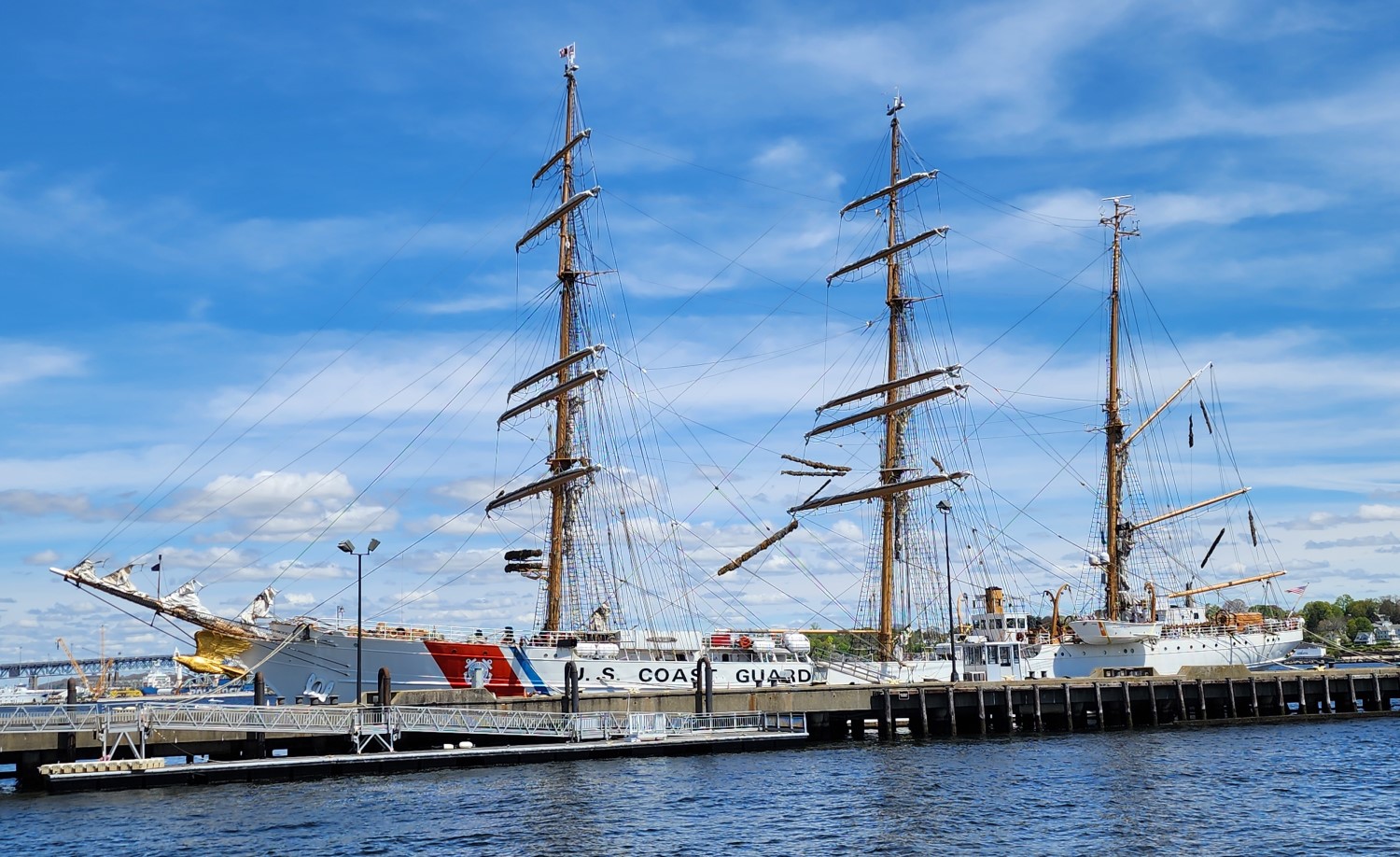
Eagle at New London4
But it was Horst Wessel that would go on to be the most famous of the type, because while the USN had abandoned sail training, the Coast Guard had never quite given up on the concept. Their last sail training ship had been retired in 1930 and not replaced, likely because of the Great Depression, but WWII gave them an opportunity in the form of the Danish training ship Danmark, in American waters for the 1939-1940 World's Fair at the outbreak of war, and ordered to remain there for safety. After Pearl Harbor, she was offered to the US government for the duration, and she helped train new officers at the Coast Guard Academy. In this role, she was useful enough that the Coast Guard requested Wessel after the war. In 1946, she was renamed Eagle and sailed across the Atlantic to her new home in New London, Connecticut, home of the Coast Guard Academy.
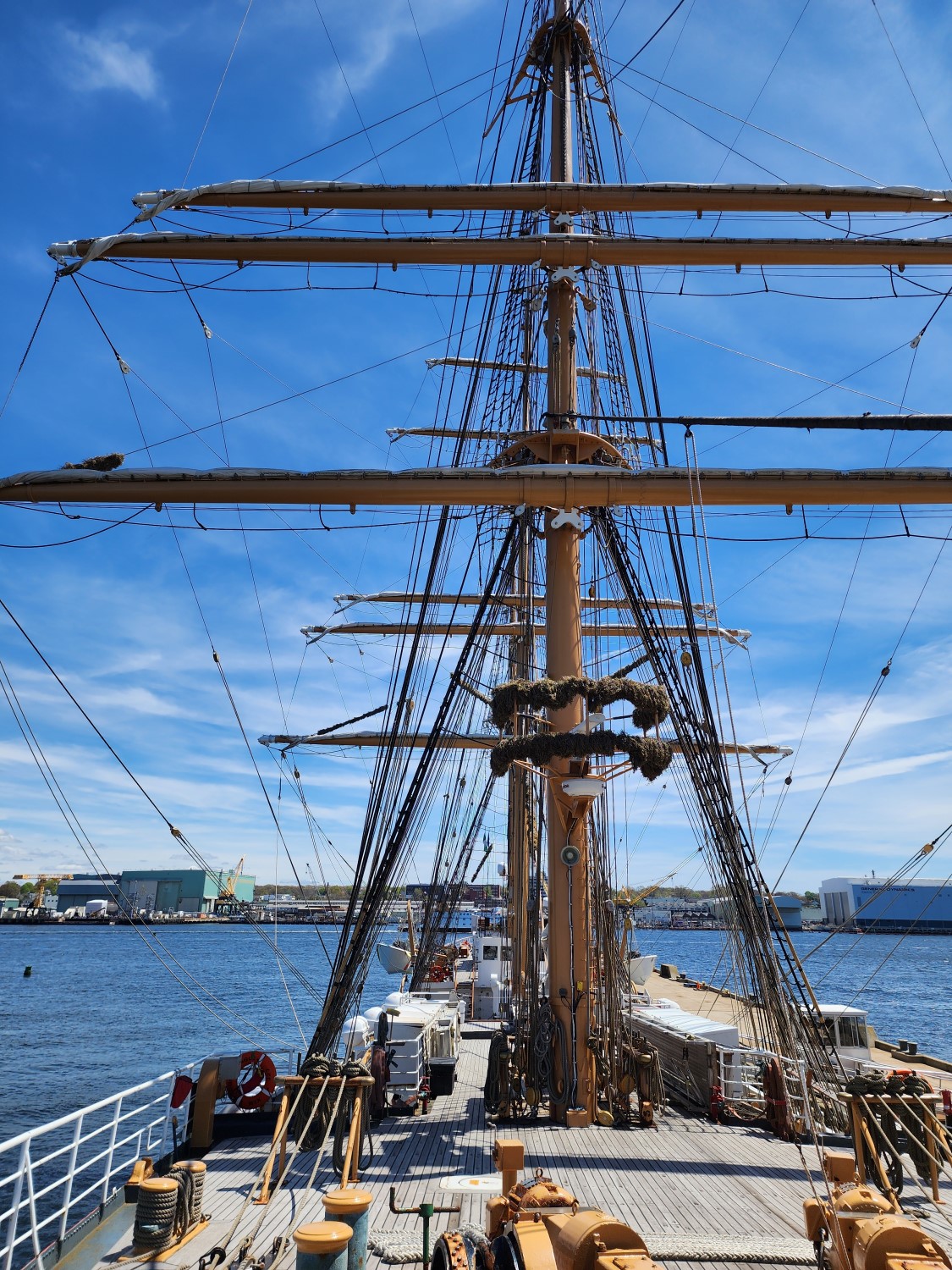
Each summer since then, she has conducted training cruises with cadets from the Coast Guard Academy. Currently, this is two six-week cruises, each with about half of the rising sophomores and a contingent of the rising seniors, a total of about 150 trainees, along with 80 permanent crew. Trainees are taught not only how to operate the sails of a square-rigged ship, but also subjects like damage control, celestial navigation, and how to operate the diesel that Eagle carries for auxiliary propulsion. The cruises frequently take Eagle to Europe or South America, and give her the opportunity to perform her secondary job, serving as a floating ambassador for the United States. Port visits are a powerful diplomatic tool, particularly when performed by a charismatic vessel like a battleship or a tall ship.5
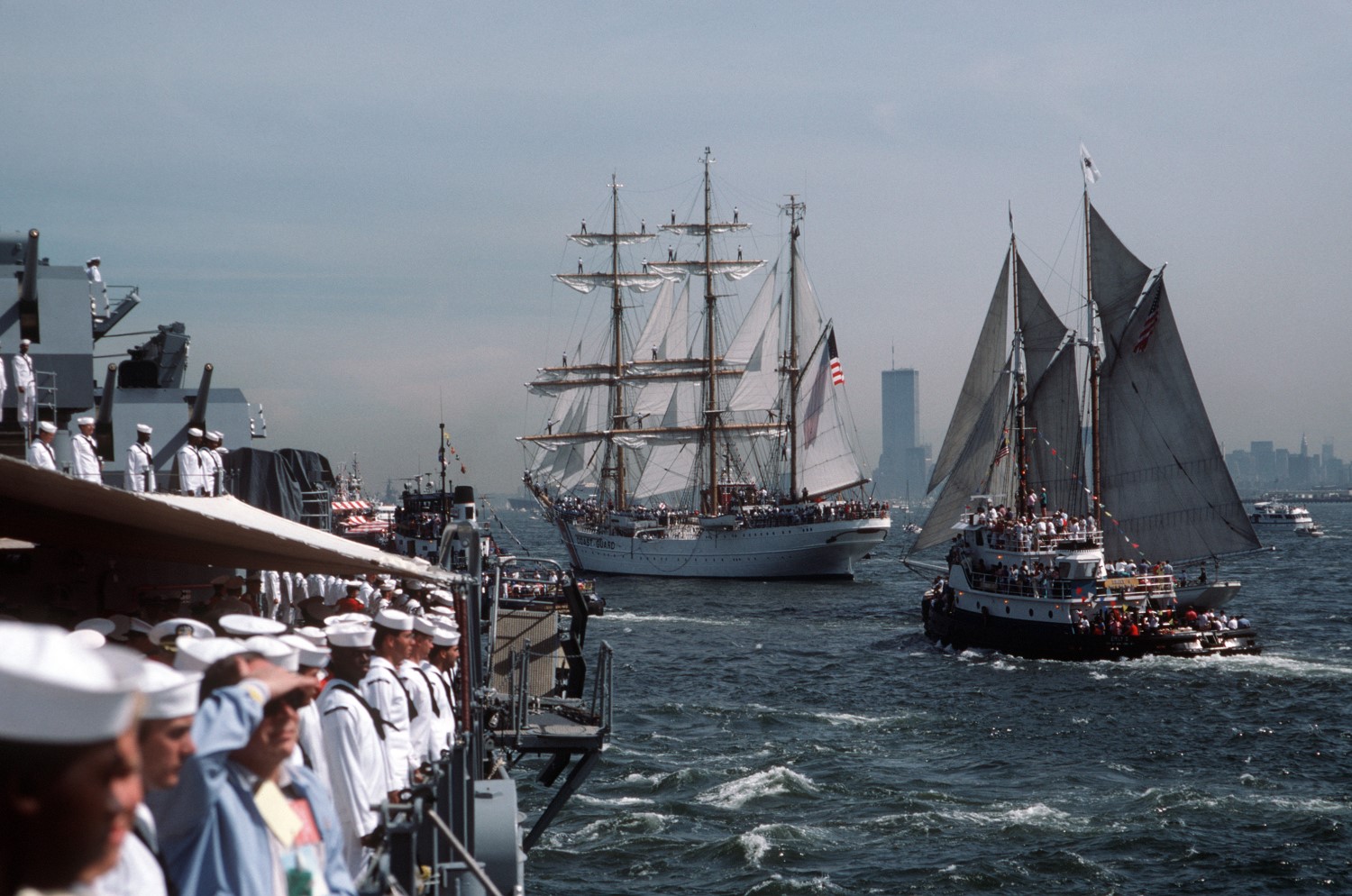
Eagle sails past Iowa during the 1986 Salute to the Statue of Liberty
Eagle also serves as the nation's representative to various gatherings of sailing ships, frequently held to mark significant events in maritime or national history. The American version, Operational Sail, has been held in 1964, 1976, 1986, 1992, 2002 and 2012, with another upcoming for the US Semiquincentennial in 2026. Eagle has served as host vessel for all of these, and frequently won the sailing race held at the start of each. She has also participated in events hosted by others, such as the Trafalgar 200 fleet review and Velas Sudamerica 2010, to celebrate the bicentennial of Argentina and Chile. Also notable was her 8-month cruise to Australia in 1987-1988, with classes for cadets continuing onboard during the trip.
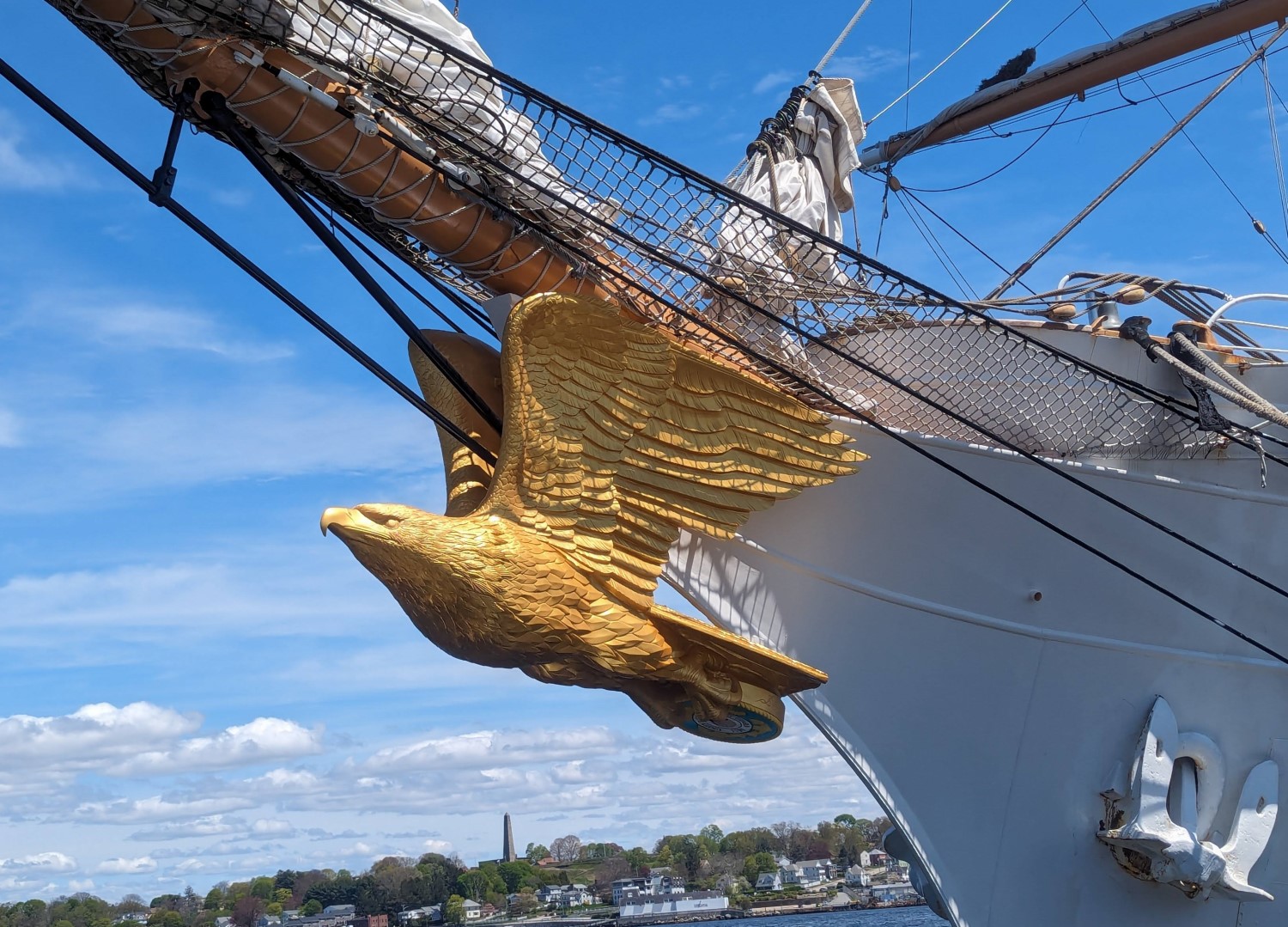
Eagle's figurehead6
Obviously, Eagle has been modernized over the years, with a new diesel engine, more comfortable living quarters, and facilities for female cadets. A notable early modernization was to the figurehead, which now clutches a Coast Guard emblem instead of the original swastika. Swastikas kept showing up under the paint for decades, although they may have finally stripped her down to bare metal to remove the problem. As far as I am aware, there are no plans to replace Eagle, now approaching her 90th birthday, and she will continue to train cadets for decades to come.
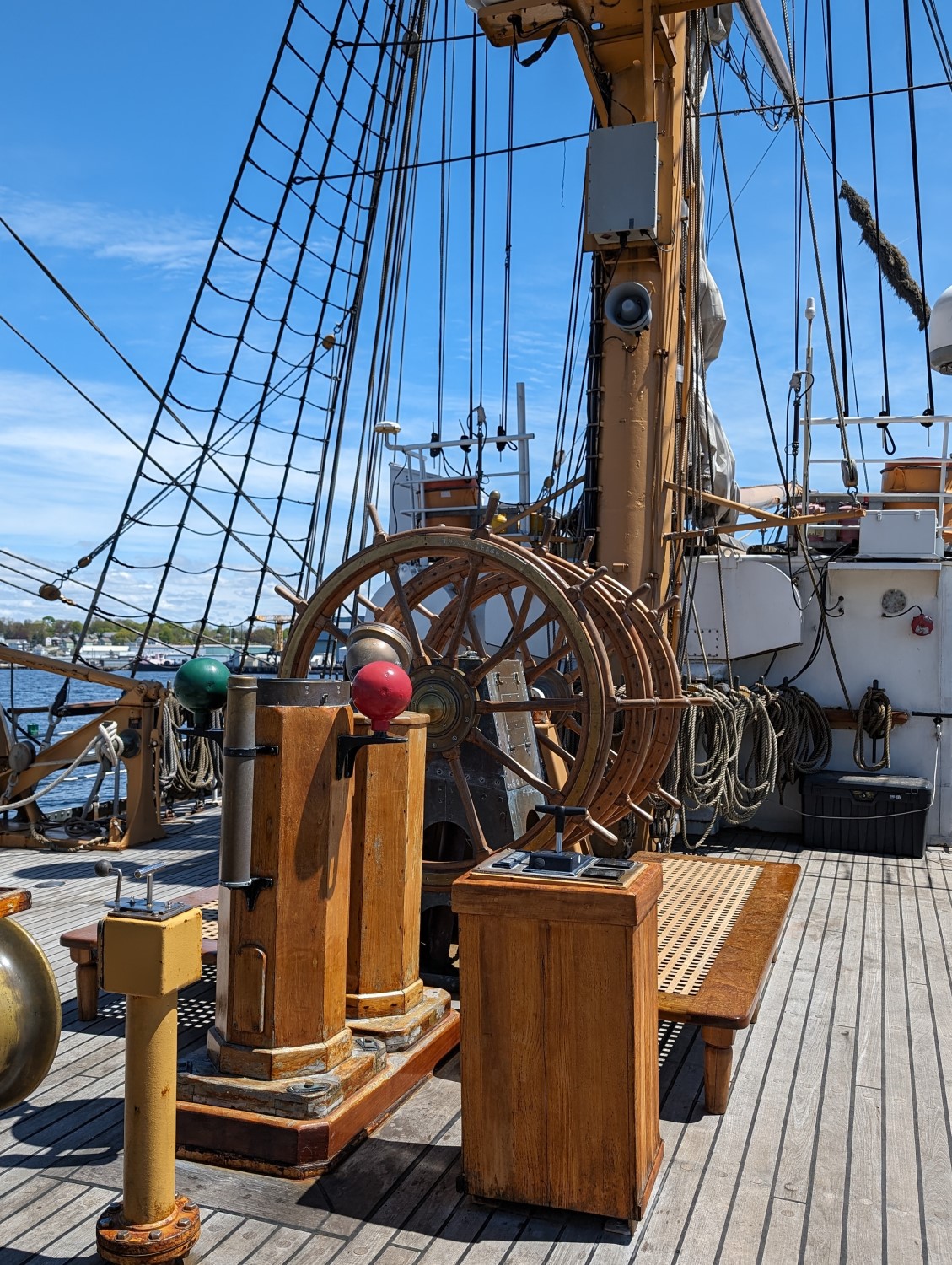
Eagle's wheel
While at the 2024 Naval Gazing meetup, we had the rare and unexpected opportunity to go aboard Eagle. We had gone to Fort Trumbull in New London for lunch as part of my continued quest for a look inside a Third System fort. Unfortunately, it was closed, but we were able to wander the fort's grounds, and as we rounded the front, we saw three masts. I realized that they were in the direction of the Coast Guard station I'd seen on the map, and took off running. My suspicions were confirmed, and even more astonishingly, they were happy to let us go aboard and wander the weather deck. Eagle was smaller than I expected,7 but in lovely shape. She's a mix of the modern (radars and winches) and historical (the helm has three wheels, to allow more sailors to help steer in bad weather). Obviously, there was no signage, but the group had enough knowledge to be able to discuss what we were looking at, and it was extremely cool to walk the decks of such a legendary vessel.
1 A barque (sometimes spelled bark) is a sailing ship with at least three masts, with the aftmost mast rigged fore-and-aft and all other masts square-rigged. ⇑
2 Gorch Fock was a German maritime poet and writer, killed aboard Wiesbaden at Jutland, so he was a suitable figure to name the new ship after. ⇑
3 Sadly, at this point best known for running into the Brooklyn Bridge in May 2025. ⇑
4 Photo courtesy of Hunter. ⇑
5 The technical term for a historical sailing vessel, more or less defined as having topsails. Modern sailing rigs generally have a few large sails, as this allows them to be worked with small crews that don't have to go aloft. Manpower is expensive, so this is desirable for all purposes except training. ⇑
6 Photo courtesy of Ian Argent. ⇑
7 I encountered her through S.M. Stirling's Nantucket series, where she plays a starring role. ⇑

Comments
Nominative determinism at work. Though I assume they don't play the corresponding song.
Footnote 2: Wiesbaden, not Weisbaden.
So real navies.
Almost as if those who continued it were a bit insecure.
One consideration may have been that WWI and even more so WWII resulted in broad naval expansion to the point where the few windjammers left in the world would be hopelessly inadequate to train the officers for any "real navy". Even if you think it's a good idea, if you don't have the resources you have to find another way and make it work.
Or build new sail training ships, and as noted there was some of that in Germany first in the 1930s and again in the 1950s. But that's a very specialized skill set with no other demand, and more generally it seems rare for navies to invest in new-build ships just for training.
The Coast Guard also seems like it has more of a focus on small boat handling / seamanship by virtue of its mission. "Every Coastie an actual sailor" seems reasonable in the same vein as "Every Marine a rifleman".
Actually, looking at this a bit more, there is a company in Poland that still builds large sailing ships on demand, https://choren.com.pl/en/
Russia has at least two modern(ish) sail training ships from them, the "Mir" built in 1987, and the "Pallada" from 1989. Both operated by naval academies rather than by the navy itself. The most recent sail training ship is the Vietnamese Navy's "Lê Quý Đôn", launched in 2014.
I don't think it was the world wars. There was always acknowledgement of the difference between temporary and permanent officers, and while you obviously couldn't offer 90-day wonders sail training, there was nothing stopping Annapolis and Darthmouth from continuing to do it. Even the Coast Guard only applies it to those who go through the Academy, which from a quick check is half their officers (or was in FY99, anyway), while the other half go through OCS (they don't have ROTC). I suspect (I decided not to spend a bunch of time digging into this) that the USN and RN got rid of it as part of modernization drives in the late 19th century. Both services had a complicated relationship with sail, and it would have been quite easy for sail training to get lumped in with sail in general in that era.
(To be clear, I make no comment on the advisability of the practice, beyond saying that Eagle was very cool.)
@redRover: if it were that, it seems weird that the Coast Guard does tall-ship sailing and the Navy small-boat sailing, rather than the other way round.
@bean: They weren't always conflated - the opinion that active warships had kept their sails too long but sail training was useful did exist - but I don't know if it was common.
On actual sailing in emergencies: the lifeboats carried by WWII cargo ships had sails. I also know of one case where improvised sails were used to save a ship after power loss (a USN submarine with a fuel leak, in 1921; I don't know whether anyone involved had formal sail training). However, these don't seem to have been the driver of the big-ship kind of sail training: the first is small-boat sailing, and the second is probably much too rare to be worth it.
@bean
Per Wikipedia, the USCG OCS classes do go out on Eagle, though not for as long as the Academy classes.
@muddywaters
I would agree if they only did tall-ship sailing, but from the USCGA website it appears that they also have a strong small-boat program for dinghies, off-shore sailing, and "small" motor vessels. https://uscga.edu/mission/waterfront-assets/ https://uscga.edu/mission/professional-development/
I admit that my view on this is basically a matter of vibes. Sail training seems like something Jackie Fisher would absolutely hate, but confirming that, and getting the full story of the demise of sail training in either the USN or RN, was going to take time I didn't want to spend on this.
I don't know either, and I agree that your guess is plausible. (Percy Scott's opinion was simply the easiest for me to find; I agree that Fisher would be a better starting point if anyone did want to research this further.)